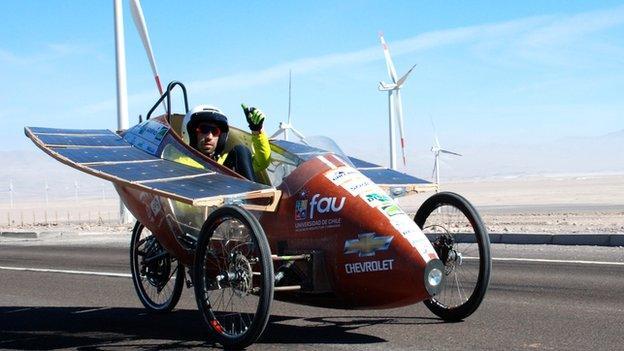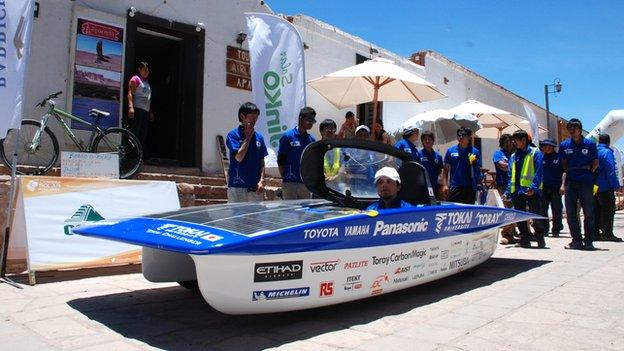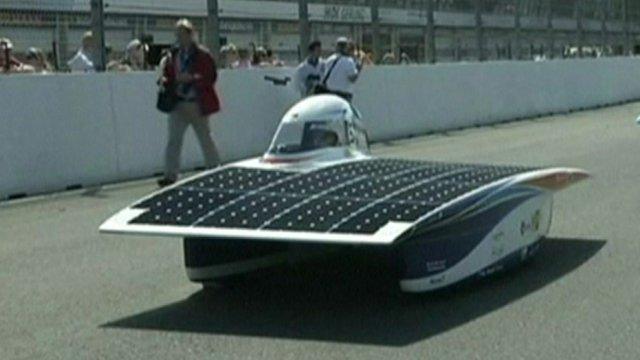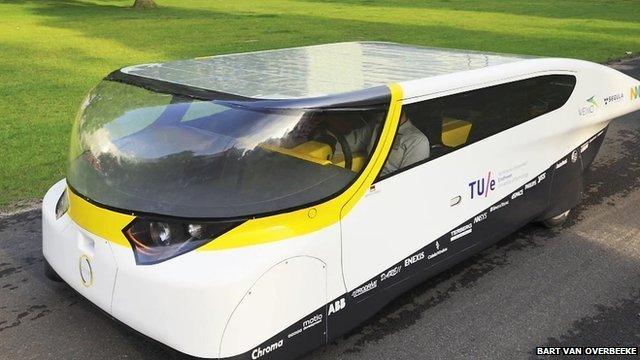Chasing the sun at Chile's Solar Atacama Rally
- Published
.jpg)
Solar-powered races are becoming popular worldwide
Rally racing in solar-powered cars has taken off in recent years, nowhere more so than in Chile's Atacama Desert, says the BBC's Gideon Long.
Motor racing is not the greenest of sports.
Whether it be Formula 1 cars hurtling around the circuit at Monza or rally cars careering along dirt tracks through Scandinavian forests, fuel consumption is always an issue, especially in today's energy-conscious world.
But in Chile this week, 20 teams are taking part in a rally in which all of the cars are powered by the sun. Carbon emissions are zero.
The Solar Atacama Rally is one of a number of such competitions to have taken off in recent years.
"They're springing up all over the place," says Dan Eberle, a judge at the Chilean race and a director of the North American Solar Challenge, one of the world's most established solar rallies.
"There are events in Australia, Abu Dhabi, South Africa, Morocco, Cyprus and Turkey, and now here in Chile."
'Weird-looking contraptions'
The Chilean rally takes the competitors over 1,400km (870 miles) through the Atacama Desert, where solar radiation rates are among the highest in the world.
The route runs within sight of the volcanoes and snow-capped peaks of the Andes mountains.
Unlike in conventional rallies, the drivers race along normal, paved roads, often to the surprise of passing motorists.
.jpg)
Many of the cars look like they should be moving on water, not land
The cars are weird-looking contraptions. Some look like boats, topped by smooth, gleaming solar panels. Others are tricycles powered partly by solar energy and partly by old-fashioned pedal power.
The fastest cars can hit 140km/h (87mph) although, as they are racing along normal roads, they have to respect Chilean speed limits.
"Chile is the best place in the world for solar radiation so that's why we wanted to come here," says Abdulrahman Alkhatib, a Saudi driver for one of the world's leading teams from Tokai University in Japan.
.jpg)
The route of the Atacama Rally takes drivers past snow-capped mountains and volcanoes
"We've already shown how good this car is in Africa and in Australia and now we wanted to test it in South America."
Alkhatib says driving a solar car is nothing like driving a normal car.
"You don't have power steering and the car is extremely light so one gust of wind can blow you off track," he says. "You're very close to the ground so you see the bumps and curves in the road very late and you have to react quickly."
Improving technology
The cars rely on photovoltaic cells to convert sunlight into electricity which is used either to power the motor directly or to charge the car's battery for later use.
The technology has improved by leaps and bounds in recent years.

The rally is held on roads used by every day users, unlike in F1 races
"The first solar car I helped build went at 24km/h (15 mph) on full sun," Mr Eberle said. "Now, some of these cars will go over 100km/h."
"The solar cells are better than they were. The cells we used back in 1984 were only 14% efficient. They're nearly twice as efficient now."
Chris Selwood, event director of the World Solar Challenge in Australia, says the weight of the batteries used in solar cars has been reduced significantly.
"The weight of the cars themselves has come down too. The new composite materials used to make the bodies are lighter and stronger than metal."
Bright future?
So, with the technology advancing so rapidly, what is the future for solar cars? Will we soon be driving them around our cities? Will we have solar panels strapped to the top of our cars?
Most observers think not.

Solar car technology has developed rapidly in recent years
It is much more likely that we will use electric cars, powered by lithium batteries which, in turn, will rely on energy from any number of sources, including solar.
"Most people in the world don't commute more than 40km (25 miles) a day, and that's well within the capability of an electric car that can draw its power from a few solar panels on the roof of the garage," Mr Selwood says.
"You don't need to drag the panels around on the car itself."
Leandro Valencia, the director of the Atacama Solar Rally, agrees.
"The cars you see here in Chile are really the Formula 1 cars of the electric car world," he says. "They're very specialised.
"But the future of electric cars in general is bright. I think we'll start to see more electric cars on the streets of Chile and elsewhere in the world within the next three years."
- Published9 August 2013

- Published17 July 2013

- Published29 September 2011